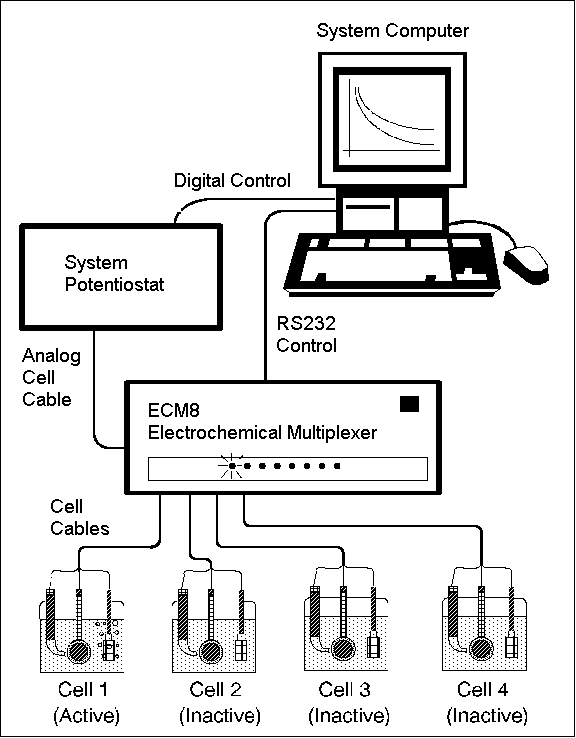System Overview
The DC Corrosion combined with an ECM8 Multiplexer is a system for cost-effective electrochemical-corrosion monitoring. You can use a multiplexed system to sequentially test eight electrochemical cells using only one high-performance potentiostat/galvanostat/ZRA. Multiplexed tests include corrosion rate versus time (via repeated polarization resistance scans), galvanic corrosion versus time, and potentiodynamic and galvanodynamic scans.
Applications for a multiplexed system include inhibitor and materials screening, on-line corrosion monitoring, and quality-control of corrosion-control products.
The figure below shows the block diagram for a Multiplexed DC Corrosion system connected to four electrochemical cells. We use this figure as the basis of the following discussion. Throughout this discussion, keywords are shown in an italic typeface.
Block Diagram for a Four-cell Multiplexed DC Corrosion System

A Potentiostat/Galvanostat/ZRA (the system potentiostat) is installed inside the host computer. Unlike in a DC Corrosion system, the system potentiostat’s cell connector is not attached directly to an electrochemical cell. Instead, the potentiostat is attached to an ECM8 Electrochemical Multiplexer. The ECM8 has eight cell ports, each of which can be connected to an electrochemical cell. Each port and its associated support circuitry is referred to as a channel.
You can think of the ECM8 as a sophisticated multi-pole switch. It can connect the potentiostat’s cell leads to any one of its cell ports. The cell that is currently connected to the system potentiostat is called the active cell. A LED on the front panel of the ECM8 indicates which channel is currently active. Cells that are not connected to the system potentiostat are referred to as inactive cells.
Unlike a simple switch, the ECM8 can do more than merely disconnect the inactive cells. They can be potentiostatically controlled by a low-current potentiostat built into each channel. If you are switching galvanic corrosion cells, the inactive cells can also be shorted. This allows galvanic corrosion to continue between measurements, minimizing the effect of multiplexing on the system. See the ECM8 Operator’s manual for more information concerning inactive-cell control modes.
The Multiplexed DC Corrosion software controls the ECM8 via an RS-232 serial connection.

Comments are closed.